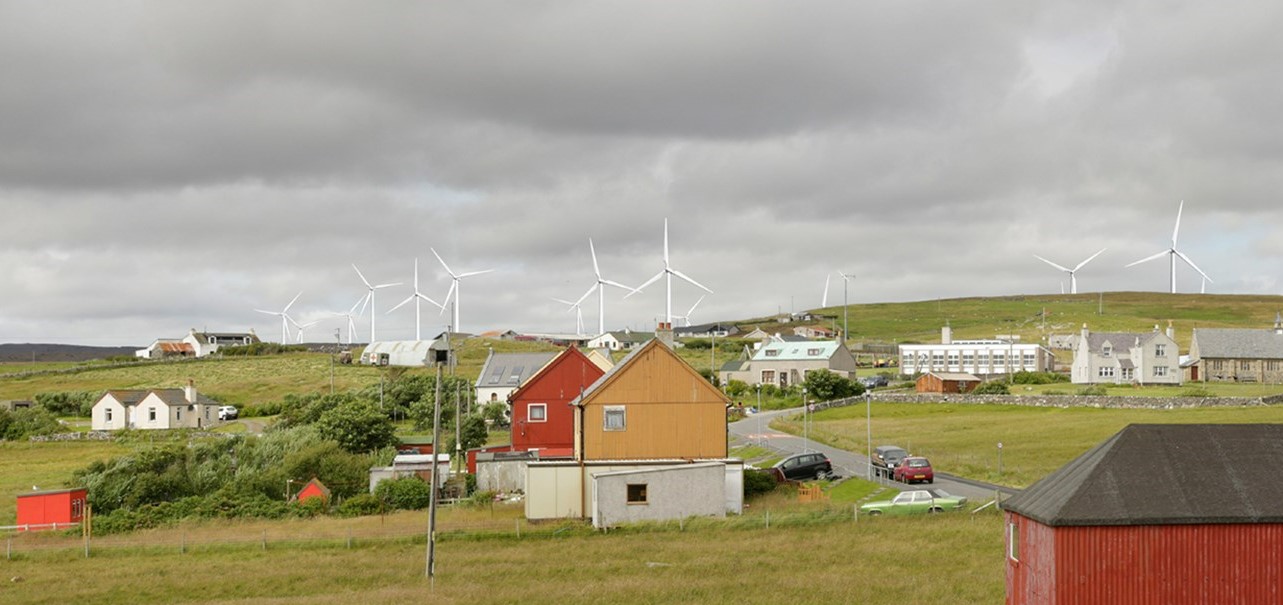Fourth round of Contracts for Difference auction delivers 3GW of clean energy for Scotland

A CGI of what the Beaw Field Wind Farm in Yell would look like
Scottish renewable energy projects won contracts to sell their power in a UK auction yesterday – at record low prices.
Offshore, two projects off Scotland’s east coast won Contracts for Difference in a competitive UK Government auction process – at just £37.35 per megawatt-hour, 6% cheaper than in previous auctions.
Onshore wind re-entered the energy market seven years after a ban saw projects stalled. Wind projects on Scotland’s remote islands also won contracts which will help make the case for new cables, further adding to the economic benefits delivered by renewables in Scotland.
And tidal power is also now competing in annual auctions, with 35MW of projects in Caithness and Orkney and 5MW in Wales granted contracts yesterday.
Business and energy secretary Kwasi Kwarteng said: “Eye-watering gas prices are hitting consumers across Europe. The more cheap, clean power we generate within our own borders, the better protected we will be from volatile gas prices that are pushing up bills.
“Thanks to today’s record renewable energy auction, we have secured almost 11GW of clean, home-grown electricity – which would provide as much power as around 6 gas fired power stations.
“These energy projects already have planning permission, now they have a funding contract in place. We’re going to these projects built as soon as possible to better protect millions of British families from rising costs.”
Just transition minister Richard Lochhead said: “It is great news that so many Scottish projects have been successful. They will deliver almost 3GW of clean energy for use in Scotland, the rest of the UK and beyond, and play a vital role in our journey to net zero.
“These results provide further evidence that renewable energy is not only clean but also delivers good value for consumers, with wind energy providing one of the cheapest forms of electricity.
“With contracts being awarded to deliver nearly 600MW of wind energy on remote islands, the need for transmission links to connect Orkney and the Western Isles is clearer than ever. Delivering this would unlock the vast renewable potential of our islands and provide huge social and economic benefits to those communities and we call on Ofgem to make this an urgent priority.”
Highlands and Islands Enterprise (HIE) has welcomed the results, which saw 12 projects across a range of technologies in the Highlands and Islands awarded more than 1GW of clean energy.
Audrey MacIver, director of energy transition and net zero at HIE, said: “This is a major milestone for the region’s renewable energy industry, which will ultimately help boost the economy and create many new jobs in the Highlands and Islands. The region, with its vast wave, tidal and wind resources, testing capabilities, unique infrastructure and supply chain expertise, is perfectly placed to capitalise on clean energy.
“We are particularly excited about the benefits that these projects will bring to our rural communities, having the potential to create exciting new economic opportunities and sustain local populations. For the Moray West offshore wind farm project, for example, Ocean Winds is expected to support 60 staff at its operations and maintenance base in Buckie.
“For the first time ever, tidal power has been included and successful in the auction process, which is a pivotal moment for the sector. With projects planned at the European Marine Energy Centre’s tidal site at Eday and MeyGen’s Phase 2 project in the Pentland Firth, this represents a long-awaited progression towards commercialisation of tidal power and secures Scotland’s lead in marine energy.
“Shetland, Orkney and the Western Isles have also seen success with Remote Island Wind projects winning contracts. For the Western Isles, this is particularly important, as it triggers the threshold Ofgem had previously set for the construction of an HVDC interconnector, connecting the islands to the UK mainland grid system and bringing significant business and community benefits.
“We would like to offer all of those teams who have been successful in securing contracts today our warmest congratulations and we very much look forward to exploring how these projects can deliver for the Highlands and Islands, and ultimately, contribute towards our just transition to net zero.”
Plans for two onshore wind farms on the Shetland Islands which would help meet Scotland’s targets for renewable energy production are a step closer to being delivered after receiving government support.
Clean energy specialists Peel NRE has been successful in bids for its Mossy Hill wind farm near Lerwick and for Beaw Field wind farm in Yell.
Proposals for the two consented wind farms represent a £150m investment by Peel NRE to help achieve Scotland’s aim to produce 50% of energy from renewable sources by 2030.
Peel NRE’s successful bids for Beaw Field and Mossy Hill wind farms bring forward the potential commercialisation of the developments on The Shetlands.
The 72MW Beaw Field wind farm received planning permission in 2017 – and will have the capacity to power around 80,000 homes a year.
Proposals for a 48MW capacity, 12-turbine wind farm at Mossy Hill were granted planning permission in 2019. This would generate enough electricity for around 50,000 homes each year.
Both schemes are due to be operational by 2026.
Peel NRE was able to enter the CfD auction this summer following Ofgem’s approval of a subsea high voltage direct current (HDVC) interconnector between Shetland and Mainland Scotland.
Rob Tate, development director for renewables at Peel NRE said: “This Government support is excellent news to help secure the future of cleaner energy generation in Scotland and it moves us closer to the delivery stage of our two wind farms in The Shetlands.
“It also supports the UK’s wider journey towards net zero and is a step in the right direction towards addressing the global energy crisis and rising costs.
“I’m pleased that both of our projects have been recognised and that we’re able to play our part in providing the infrastructure needed to scale up the country’s renewable efforts. This result is the culmination of eight years of work and investment from Peel NRE in Shetland. It’s been a huge team effort to get the bids over the line and I’d like to thank everyone for their hard work in putting the best submissions forward.”
The latest auction has also delivered a further reduction in offshore wind strike prices.
The price per MWh of offshore wind is now £37.35 per MWh, almost 70% lower than during the first CfD auction in 2015.
Claire Mack, chief executive of Scottish Renewables, told how the prices “showed how competitive renewable energy can be with the right government support” – but warned: “it is important that government understands the reality of building projects at these very low prices”.
On offshore wind, she said: “Scotland’s offshore wind potential was outlined by the recent ScotWind round, through which 17 projects received seabed leases. That new capacity, which could reach 25GW, would bring up to £24.9 billion into the Scottish economy, as well as creating tens of thousands of jobs.
“The benefits to Scottish communities which stem from this will be transformational: projects which were recently awarded seabed leases have committed to invest in Scotland – and specifically in supply chain businesses – on a scale never seen before, in any industry. This investment will deliver tens of thousands of skilled jobs, allow Scottish firms to compete in the global offshore wind market and revitalise communities which currently rely on seasonal tourism.
“While these results are positive for Scotland it is important that government understands the reality of building projects at these very low prices. Industry has said for many years that it is committed to investing in the UK supply chain, where prices are generally higher. Doing so is made much harder by the need to drive down costs in the Contracts for Difference mechanism’s competitive auction process and we would urge government to consider CfD reform away from pure cost reduction to ensure that resilience and sustainability can be embedded in the UK supply chain.”
At the price achieved yesterday (£178.54), tidal power is able to compete with other energy generation technologies – but industry body Scottish Renewables warned more must be done to ensure the sector’s future.
On tidal power, Ms Mack said: “Make no mistake, yesterday’s auction results are a turning point for tidal power, showing as they do that it has a place in the UK’s energy mix.
“But while the prices achieved in this most recent auction are an incredible milestone, it must be remembered that tidal energy is still in a developmental phase and most developers will be unable to bid so low in future. We would therefore urge the UK Government to confirm that its plans for future auction rounds include a dedicated, ring-fenced budget for tidal stream projects and also to commit to reforming the Contracts for Difference mechanism to allow UK supply chain companies to be more competitive.”
Onshore, 1.5GW of wind power achieved contracts to sell power in Scotland at £42.47 per MWh. Remote island wind projects in Orkney, Shetland and the Isle of Lewis also won, at £46.39 per MWh.
On onshore wind, Scottish Renewables’ Claire Mack added: “Onshore wind provides the bulk of Scotland’s renewable electricity capacity cheaply, predictably and alongside a whole raft of other social, environmental and economic benefits.
“The sector employs 8,800 people across our country, from the central belt to the Borders, Highlands and Islands. These are skilled jobs which bring prosperity and investment to communities where opportunities for this type of employment would otherwise not exist.
“Remote island wind in particular has a superb story to tell here, and the developments which have achieved contracts today will bring new investment and jobs to communities which have waited for many years for them to proceed.
“Onshore wind is one of the fastest ways of getting new power generation onto the grid, and if planning in Scotland is reformed to align with the climate emergency this sector can grow rapidly to continue mitigating the effects of climate change.”
78MW of Scottish solar power also won contracts in the auction.
Looking forward, Scottish Renewables told how the future of the CfD must be focused on imperatives other than just cost reduction.
CEO Claire Mack said: “The Contracts for Difference mechanism has been incredibly successful in driving down the cost of electricity, and we can see from today’s results how competitive renewable energy can be with the right government support.
“But it is clear that we have seen some unusual outcomes in terms of price which demonstrate that there is a need to look at how the costs generators are facing to get clean electricity to consumers are influencing the picture.
“Cost reduction may seem positive but the pressures of inflation, commodity prices and other external pressures mean costs are increasing across the energy industry. Renewable power, and particularly offshore wind power, faces other imperatives, too.
“If we want to see a successful UK supply chain competing with the rest of the world to help build UK offshore wind farms, developers of those projects must have more financial leeway to invest locally. The CfD should therefore move away from focusing exclusively on procuring the cheapest electricity possible and instead aim to ensure that renewable energy projects deliver economic benefits to the UK throughout their entire value chain.
“The low cost of technologies like offshore wind also mean that the imposition of caps on the amount of capacity which is able to be delivered by each auction is outdated: in the main, renewables now pay money back to the Treasury over the life of a Contract for Difference, and it is common sense to now remove these caps from coming auction rounds.
“Overall, we welcomed the government’s commitment to hold CfD auctions annually and look forward to hearing confirmed details of that process as soon as possible.”
Full results in Scotland are:
Onshore Wind (Strike Price: £42.47/MWh)
- Cumberhead West (119.70MW)
- Arecleoch Wind Farm Extension (74.10MW)
- Kilgallioch windfarm extension (51.30MW)
- Stranoch Wind Farm (99.96MW)
- North Kyle Energy Project (212.00MW)
- Hagshaw Hill Repowering (79.80MW)
- Broken Cross Wind Farm (48.00MW)
- Douglas West Extension (71.50MW)
- High Constellation Wind Farm (50.00MW)
- Chirmorie Wind Farm (81.60MW)
Solar Photovoltaic (Strike Price: £45.99/MWh)
- Milltown Airfield Solar PV (49.90MW)
- Speyslaw Solar PV (20.00MW)
- Cullerlie Solar PV (8.75MW)
Remote Island Wind (Strike Price: £46.39/MWh)
- Stornoway Wind Farm (200.00 MW)
- “Orkney Community Wind
- Farm Project - Hoy” (28.80MW)
- Orkney Community Wind Farm Project - Quanterness (28.80MW)
- Mossy Hill (48.00MW)
- Beaw Field (72.00MW)
- Viking Wind Farm (220.00MW)
Tidal Stream (Strike Price: £178.54/MWh)
- Orbital Marine Eday 2 (4.80MW)
- Orbital Marine Eday 1 (2.40MW)
- MeyGen Phase 2 (28.00 MW)
Offshore Wind (Strike Price: £37.35/MWh)
- Inch Cape Phase 1 (1080.00MW)
- Moray West Offshore Wind Farm (294.00 MW)





















